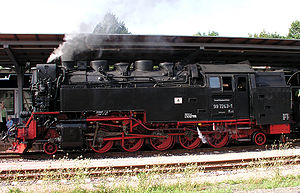- DR Class 99.23-24
-
DR Class 99.23-24 Number(s): 99 231–247
ab 1970: 99 7231–7247Quantity: 17 Manufacturer: VEB Lokomotivbau "Karl Marx" Babelsberg Year(s) of manufacture: 1954–1956 Wheel arrangement: 2-10-2 Axle arrangement: 1'E1' h2t Type: K 57.10 Gauge: 1,000 mm Length over buffers: 12,500 mm Height: 3,650 mm Width: 2,645 mm Overall wheelbase: 8,700 mm Empty weight: 47.5 t Service weight: 60.5 t Adhesive weight: 47.5 t Axle load: 9.5 t Top speed: 40 km/h Indicated Power: 515 kW (700 PS) Starting tractive effort: 102.9 kN (10.5 Mp) Driving wheel diameter: 1,000 mm Carrying wheel diameter: 550 mm Valve gear: Heusinger with Kuhn slides No. of cylinders: 2 Cylinder bore: 500 mm Piston stroke: 500 mm Boiler Overpressure: 14 bar No. of heating tubes: 114 No. of smoke tubes: 32 Grate area: 2.8 m² Radiative heating area: 10.4 m² Superheater area: 30 m² Evaporative heating area: 95.5 m² Water capacity: 8 m³ Fuel: 4 t coal Brakes: Ke G-P mZ Locomotive brakes: Hardy vacuum-controlled compressed air brake with Knorr auxiliary brake, converted to direct-release commpressed air brake with KNORR EMV10 control valve and auxiliary brake Train brakes: Hardy vacuum brake, converted to Knorr compressed air brake Couplers: Equalising lever couplers (Balancierhebelkupplung); in Eisfeld: Janney central buffer couplers The engines of DR Class 99.23 are metre gauge steam locomotives, that were procured by the Deutsche Reichsbahn (DR) in East Germany from 1954 to 1956. When they entered service they had operating numbers 99 231–99 247. Today they are numbered 99 7231–99 7247.
Contents
History
Between 1954 and 1956 a total of 17 locomotives were bought by the DR for the railways of the Harzquerbahn and Brockenbahn and for the line from Eisfeld to Schönbrunn. They replaced much of the very old fleet. The first seven units (99 231 to 99 237) were originally equipped with two Krauss-Helmholtz bogies. Due to problems with curve running the engines in the second series were given Beugniot levers between the first and second coupled axles in addition to the Krauss-Helmholtz bogies.[1]. (according to other sources also a Schwartzkopff-Eckhardt II bogie [2][3][4][5]). The locomotives of the first series were subsequently modified with Beugniot levers, some in the early 1960s, others in 1973/74 (on the Harz lines). The thinner wheel flanges of the driving wheels were completely removed later in order to achieve better curve running. Certainly the engines in the second series did not have a rigid wheelbase.[2]
The drive was applied to the third coupled axle, the locomotives had Heusinger valve gear with unsprung Müller balanced slide valves and, later, Trofimoff valves.
These Neubaulokomotiven were a fully welded evolutionary development of the standard locomotives (Einheitsloks) of the DRG Class 99.22. In contrast to those, the 99.23-24s had mixer-preheaters and plate frames. However, the latter caused maintenance difficulties from the outset due to cracks and distortion. To date five locomotives (the present-day 99 7232, 7240, 7245, 7239, 7236) were equipped from 2004 onwards with a new, redesigned plate frames and new, welded, steam cylinders. More should follow. All the engines still exist and are based in the Harz; some however are no longer working.
The engines were converted between 1977 and 1983 to primary oil-firing and are the most powerful German narrow gauge steam locomotives ever to have been built. They are primarily used on the line up to the Brocken from Wernigerode.
Their operating numbers changed from 99 231 et seq to 99 7231 et seq on the introduction of computerised numbers in 1970 and then again to 99 0231 et seq on conversion to oil-firing. The computer numbers are still valid, because the HSB retains those allocated in the 1970 DR renumbering scheme.
The vehicles can carry 4.0 tonnes of coal and 8.0 m³ of water.
Locomotives
- 99 7231: out of service
- 99 7232: boiler licence expired, new frame
- 99 7233: out of service
- 99 7234: awaiting general inspection
- 99 7235: working
- 99 7236: working, new frame
- 99 7237: working
- 99 7238: working
- 99 7239: working, new frame
- 99 7240: working, new frame
- 99 7241: out of service
- 99 7242: working
- 99 7243: working
- 99 7244: out of service
- 99 7245: working, new frame
- 99 7246: out of service
- 99 7247: out of service
Photo gallery
Sources and references
- ^ Weisbrod/Wiegard/Müller/Petznik: Deutsches Lok-Archiv: Dampflokomtiven 4. Baureihe 99, transpress Berlin 1995, ISBN 3-344-70903-8
- ^ a b EK-Themen 18, Brockenlok 99.22, Eisenbahn-Kurier, Freiburg 1995
- ^ Obermayer: Taschenbuch Deutsche Schmalspur-Dampflokomotiven. Franckh'sche Verlagshandlung, Stuttgart 1971, ISBN 3-440-03818-1
- ^ Kühne. Alles über DDR-Dampfloks, transpress, Stuttgart 2008, ISBN 978-3-613-71335-2
- ^ Website of the Freundeskreises Selketalbahn (see below)
Literature
- Weisbrod, Manfred; Wiegard, Hans; Müller, Hans; Petznick, Wolfgang. Deutsches Lok-Archiv: Dampflokomotiven 4 (Baureihe 99), transpress, Berlin,ISBN 3-344-70903-8, 1995, pp 53–57.
- Vetter, Klaus J. Das große Handbuch deutscher Lokomotiven, Bruckmann, München, ISBN 3-7654-3764-6, 2001, pp 191–192.
- Obermayer, Horst J. Taschenbuch Deutsche Schmalspur-Dampflokomotiven, Franckh'sche Verlagshandlung, Stuttgart, ISBN 3-440-03818-1, 1971, pp. 60–61.
See also
External links
- Freundeskreis Selketalbahn website
- HSB website
- There is a relevant English-language forum at Railways of Germany
Classes of German steam locomotives Deutsche Bundesbahn (DB) Neubaulok classes 
Deutsche Bundesbahn (DB) Umbaulok (rebuild) classes Deutsche Reichsbahn (DR) Neubaulok classes Deutsche Reichsbahn (DR) Rekolok classes Deutsche Reichsbahn-Gesellschaft (DRG) classes Categories:- Steam locomotives of Germany
- 2-10-2T locomotives
- Deutsche Reichsbahn (East Germany) locomotives
- Railway locomotives introduced in 1954
Wikimedia Foundation. 2010.




